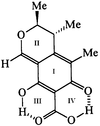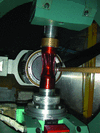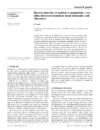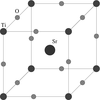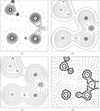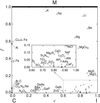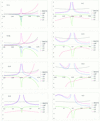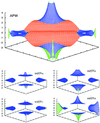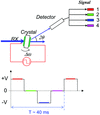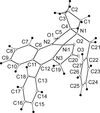issue contents
September 2004 issue
New information from modern charge density methods
Third European Charge Density Meeting with European Science Foundation Exploratory Workshop

Cover illustration: Molecular electrostatic potential colour-mapped on an isodensity surface for polymorph B of the anti-ulcer drug famotidine. See Overgaard & Hibbs [Acta Cryst. (2004), A60, 480-487].
research papers
The comparison of theory and experiment in charge-density analysis remains a cornerstone of the field. Various levels of comparison are discussed, including static and dynamic electron densities, topological properties, d-orbital occupancies, electrostatic moments and intermolecular interactions, as well as the structure-factor restraint introduced in quantum-mechanical energy minimization by Jayatilaka and co-workers.
Open  access
access
 access
accessElectron distributions from multipolar refinement of two sets of high-resolution X-ray diffraction data of different quality, measured at T = 19 K from two different spherical crystals of the same compound, are analysed and compared.
Download citation


Download citation


The charge density of urea is studied with a multipole model using very high precision synchrotron-radiation diffraction data.
Download citation


Download citation


A new magnetic metal-organic framework material, [Mn2(C8O4H4)2(C3H7ON)2], has been synthesized. The magnetic susceptibility and heat capacity has been measured from 2 to 400 K, and the electron density has been determined from 16 (1) K single-crystal synchrotron X-ray diffraction data.
Download citation


Download citation


The bright synchrotron radiation at a short wavelength of ∼0.5 Å combined with low temperatures and modern CCD area detection provides outstanding experimental conditions for charge-density determinations. Synchrotron-based studies on several compounds are summarized, for example atomic properties of a highly substituted C60 fullerene with about 100 atoms are reported.
High-quality γ-ray structure factors are used to explore the electronic charge distribution in prototypic antiferromagnets.
A charge-density study of SrTiO3 by extinction-free electron diffraction.
The shadowing of the primary and reflection beams in high-pressure powder diffraction experiments using a diamond-anvil cell is analysed and a method for correcting reflection intensities is described. These corrections considerably improve the accuracy of the data, essential for electron-density determinations.
Electronic and exchange energy densities, a local temperature and local entropy as well as a local Fermi momentum and one-electron potential calculated from the experimentally derived electron density and its derivatives using approximate functionals of the density functional theory are considered. Their application to studies of the electron structure of compounds with different types of chemical bonds is given.
Open  access
access
 access
accessThe electrostatic potential can be used as an appropriate and convenient indicator of how transferable an atom or functional group is between two molecules. Quantum-chemical topology is used to define the electron density of a molecular fragment and the electrostatic potential it generates.
Some of the latest advances in the analysis of electron density are reviewed, including topological indices that provide a useful characterization of the global properties of the density, specific results on some prototypical metal and low heteropolarity systems and calculation of the local curvature of the interatomic surface.
The local form of the source function for the electron density at a given point is introduced and analysed for the second-row diatomic hydrides and a number of prototypical hydrogen-bonded systems. Differences in the local source contributions to the density at bond critical points due to chemical bonding (deformation density) and crystallization (interaction density) are also explored and are found to be more informative and experimentally detectable than are the corresponding changes for the bond-critical-point properties of intermolecular interactions.
The collapse under pressure of the antiferromagnetic ground state of the potassium–rubidium electro-sodalite is studied. The linearized augmented plane wave with local orbitals basis set is described and the special considerations needed for setting it up for systems such as the electro-sodalites are discussed.
Electron-density studies of molecular magnetic materials are reviewed.
Studies of electric field induced structural and electron-density modifications by X-ray diffraction
The results obtained by diffraction from crystals under electric fields are reviewed and are illustrated by examples for a number of different compounds.
Open  access
access
 access
accessThe experimental considerations required to obtain photoinduced crystal structures is described and related to the experimental and theoretical requirements of charge-density studies. The viability of combining these two experimental methodologies to realize a photoinduced charge-density study is explored.
Download citation


Download citation


A multipole description of the electron-density distribution in the two polymorphs of famotidine is given. The electrostatic potential shown on the molecular surfaces provides additional information on molecular reactivity.
A 12 π-electron delocalized system and Csp3—H⋯H—Csp2 weak dihydrogen interactions of tetra-tert-butyl-s-indacene are confirmed through topological analyses of the total electron density.
Download citation


Download citation


The experimental electron density ρ(r) of the two isomorphic salts KMnO4 and KClO4 was determined by a multipole analysis of accurate X-ray diffraction data at 120 K. The quantum theory of atoms in molecules was applied and the bonds were characterized using the topological parameters at the bond critical points.
Download citation


Download citation


The behaviour of bridged metal–metal bonds at varying temperatures is studied.
Download citation


Download citation


Charge-density studies of an NiII complex of the Schiff base of (S)-N-(2-benzoylphenyl)-1-benzylprolinamide and glycine prove an interaction between the Ni2+(dz2) orbital and benzyl π-electron density.


 journal menu
journal menu









